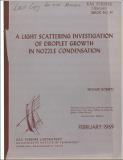| dc.contributor.author | Roberts, Richard, Sc. D. Massachusetts Institute of Technology /, by Richard Roberts | en_US |
| dc.contributor.other | Massachusetts Institute of Technology. Gas Turbine Laboratory | en_US |
| dc.date.accessioned | 2016-10-06T21:22:04Z | |
| dc.date.available | 2016-10-06T21:22:04Z | |
| dc.date.issued | 1969 | en_US |
| dc.identifier.uri | http://hdl.handle.net/1721.1/104705 | |
| dc.description | February 1969 | en_US |
| dc.description | Also issued as: Thesis (Sc. D.)--Massachusetts Institute of Technology, Dept. of Mechanical Engineering, 1969 | en_US |
| dc.description | Includes bibliographical references (leaves 82-87) | en_US |
| dc.description.abstract | An experimental and theoretical study has been made of the condensation of water vapor (with air carrier) in a supersonic nozzle in order to investigate the possible existence of condensate droplets which are substantially larger than predicted by the standard application of classical condensation theory. Droplet size was measured using light scattering techniques, which when combined with the total mass concentration of condensate, provided limits on the maximum and average droplet size. It was found that approximately one part in 10 of the droplet concentration reached a size a factor of 10 greater than predicted by the classical theory . . .The maximum droplet size, furthermore, was not seen to decrease proportionately as the nucleation zone was approached, indicating that the larger droplets are formed during the early stages of condensation. Inconclusive evidence suggests that this occurs following the completion of nucleation but before the vapor supply is exhausted. A calculation procedure which allowed the separation of the nuclei into a distribution of sizes, arising from a varying stability criterion and radius dependent growth rate, resulted in the establishment of a qualitatively correct distribution shape but no theoretical substantiation of an aging or coarsening mechanism. A separate application of Brownian coagulation theory to surface-averaged condensation theory resulted in the prediction that the average droplet size increased by a factor of between 2.5 and 4. No conclusion could be drawn concerning the actual existence of this size increase due to the level of uncertainty in the determination of average droplet size. | en_US |
| dc.description.sponsorship | Research was carried out under the Sponsorship of the U. S. Navy, Office of Naval Research, Power Branch Contract Nonr 3963(07) | en_US |
| dc.format.extent | xiv, 125, 12 leaves | en_US |
| dc.publisher | Cambridge, Mass., Gas Turbine Laboratory, Massachusetts Institute of Technology, 1969 | en_US |
| dc.relation.ispartofseries | GTL report #97 | en_US |
| dc.subject.lcc | TJ778.M41 G24 no.97 | en_US |
| dc.subject.lcsh | Vapors | en_US |
| dc.subject.lcsh | Light -- Scattering | en_US |
| dc.subject.lcsh | Supersonic nozzles | en_US |
| dc.subject.lcsh | Drops | en_US |
| dc.title | A light scattering investigation of droplet growth in nozzle condensation | en_US |
| dc.type | Technical Report | en_US |
| dc.identifier.oclc | 14183858 | en_US |
